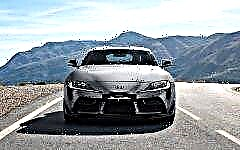

The content of the article:
- Most reliable hatchbacks in Japan
The hatchback is one of the most popular body types with an aesthetic appearance, comfortable interior, spaciousness, excellent driving performance and versatility.
Our ranking includes some of the best hatchbacks of 2019, deserving the attention of motorists.
Most reliable hatchbacks in Japan
Mazda 3

The Japanese brand has become a benchmark for style, aggressive character and functionality, whatever model is involved. This hatchback is distinguished by a strict design, well-separated interior and rich technical equipment.
First of all, Russia received a version with a 120-horsepower 1.5-liter engine, aggregated with a 6-speed automatic transmission and capable of developing 190 km / h.
In the fall, another version of the power unit will appear - a 2-liter 150-horsepower with a fuel consumption reduced to 5.8 liters per hundred kilometers.
The new model stands out with a more impressive false radiator grille, narrow optics, a hood that has lost its bulge and smoother side lines. A spoiler over the rear window and tailpipes on the lower bumper combine to make the car both sporty and discreet.
In the basic equipment Drive, the owner will receive LED headlights, halogen running lights, power windows, heated and electric mirrors, air conditioning, a multimedia system with an 8.8-inch screen, 7 airbags and a number of important electronic assistants.
Optionally, the 1.5-liter engine can be supplemented with adaptive cruise control, emergency braking and traffic sign recognition.
Finally, owners will appreciate the high safety of this model, which is provided by the G-Vectoring Control system for the most reliable grip on any type of surface and in any climatic conditions.
Toyota Auris

Auris is consistently in demand in the car market due to its combination of reliability, economy and budget. The hatchback boasts good technical performance, including a line of power units with a capacity of 97 to 147 hp. with., which is more than enough for a compact car.
In the new generation, the exterior of the Auris impresses with complex headlamps with LED running lights.
The hood became more prominent, the large bumper was equipped with a huge air intake, and the overall profile became more sporty and fit due to the swollen wheel arches, a sloping roof, and elegant stamping.
At the stern, there is a small spoiler, spectacular LED lights, vertical fog lights on the bumper, a diffuser with exhaust system trunks.
The model is equipped with a petrol 102-liter 116-horsepower engine, as well as two hybrid options for 122 liters. with. or 180 l. with.
At the heart of the car is the TNGA platform, which implies a lower center of gravity, and with it better handling. The manufacturer emphasizes upgrades such as electric power steering, fully independent multi-link suspension with MacPherson struts, ventilated disc mechanisms on the front wheels that provide a balance of comfort and dynamic character.
Combined with low gas consumption of up to 5.4 l / 100 km, acceleration from 0 to 100 in 10 seconds and a smooth ride, the car looks like an excellent option for long trips.
Infiniti Q30

Those who associate hatchbacks with family transport should take a closer look at this model with a daring profile, a predatory squint of headlights, a brutal grille and a sporty long hood.
A wide windshield, large wheel arches, chrome Infiniti struts create a fresh and modern look.
A modification with two petrol engines entered the Russian market: a 1.6-liter 149-horsepower and a 2-liter 211-horsepower turbocharged, aggregated 7-speed robotized transmission. They consume in mixed mode no more than 5.8 liters in a weaker version and 6.7 liters in a powerful one.
A model was built on the MFA platform, which is traditionally used for Mercedes products and has a transverse arrangement of the power plant. Suspensions are traditional - independent front MacPherson strut and multi-link rear.
With the variety of configurations offered by the manufacturer, even the basic one has good equipment:
- parking sensors;
- audio system with six speakers;
- 2-zone climate control;
- heated front seats;
- electric glass unit;
- 7 airbags;
- several security assistants.
The creators did a really good job on safety, equipping it with a frontal collision warning system and emergency braking, an automatic light control function, and intelligent cruise control.
Making a choice in favor of the Infiniti Q30, motorists note an interesting appearance, low maintenance costs, excellent quality of finishing materials, excellent noise insulation, maneuverability and dynamics.
Nissan leaf

The demand for this front-wheel drive electric vehicle is primarily due to its affordable cost, which compensates for the small range.
The appearance of the model is harmonious and sporty: panoramic glass, sloping roof, massive wheel arches and a rear bumper, equipped with foglights and diffusers, a body kit.
The salon is finished with high-quality fabric and leather, has plastic and metal elements, the interior space provides a comfortable seating for five passengers, each seat of which is equipped with a heating system.
The boot volume of the Nissan Leaf is 435 liters, which is quite a lot for a C-class car, and with the rear row folded down, the owner will receive 850 liters.
The vehicle is powered by a 150-horsepower electric motor with 320 Nm of torque and a 40 kWh lithium-ion battery. This combination accelerates the hatchback to 144 km / h and accelerates from 0 to 100 km / h in 7.9 seconds.
The only complaint is the distance that the electric car can cover. The cruising range according to the Japanese standards is 400 km, the European calculations say 378 km, and the American ones are even less - only 241 km. Full battery recovery takes 8-16 hours using standard household power, while a full-fledged charging station will replenish energy in just 40 minutes.
The basic equipment supplied to the Russian car market includes:
- power steering;
- climate control;
- heated rear window;
- eco-mode;
- Rain sensor;
- several basic electronic assistants.
Test drives show that this hatchback has good handling and a high level of safety, a pleasant appearance and internal comfort, a quiet and economical engine. Thus, the Leaf is in line with the current trend of moving towards stylish, practical, environmentally friendly and economical vehicles.
Honda jazz

A very interesting city car, with a striking appearance and compact dimensions with high roominess and performance.
This Japanese hatchback has received an unusual combination of a small hood with the widest windshield, set at a strong slope.
Raised sides and curved head optics stripes give the hood a cunning and somewhat aggressive expression of the "muzzle", logically complemented by a branded air intake grille with a graceful central glossy stripe.
The body kit is quite impressive, and the stylish sides received a lot of relief, mainly concentrated in the area of u200b u200bthe doors and wheel arches.
Surprisingly, with a really spectacular appearance, the interior of the creators of the model turned out to be more than modest: simple finishing materials, not the highest quality plastic and only artificial leather, and the seats have weak lateral support, but they are heated.
In the back row, three adults will be able, albeit tightly, to accommodate, and the trunk volume of the Honda Jazz is 350 liters.
The range of power units is small: two petrol options for 102 and 130 liters. sec., paired with a 6-speed variator or manual transmission. The modest parameters of the engines are compensated by the rational fuel consumption of the Nissan Leaf of 4-5 liters per hundred kilometers.
The basic equipment package contains: 6 airbags, air conditioning, a multimedia system with a touch screen, rain and light sensors, heated seats and rear-view mirrors. Much attention is paid to the safety system, expressed not only in the airbags, but also in the four curtain airbags under the ceiling trim
Although in Russia this model is not often seen on the roads, in Europe this small car is in great demand for its stylish appearance, maneuverability, good equipment and economy.
Conclusion
The hatchbacks produced by Japanese manufacturers can be roughly classified into two groups: compact, maneuverable runabouts for urban management and powerful, impressively sized models. Thus, motorists get a wide range of reliable and stylish hatchbacks of any size, price range, roominess and functionality.











